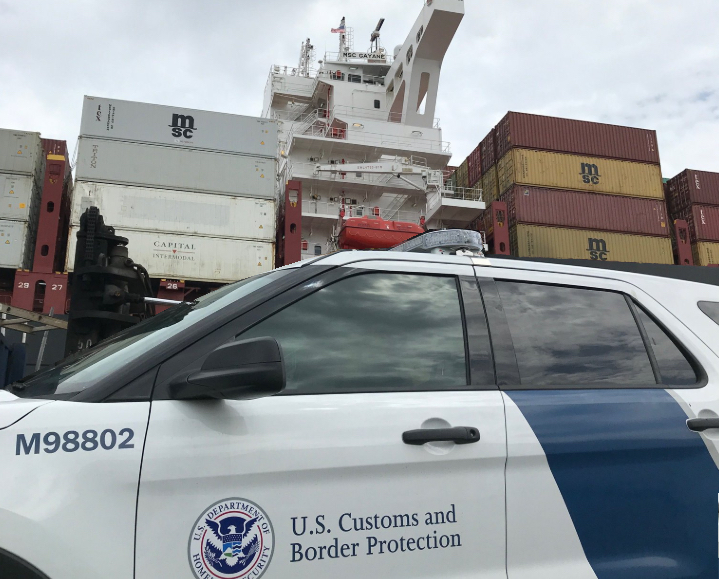Customs officials in Philadelphia made an unexpected discovery on June 18 during a routine inspection of a cargo ship arriving from Buenaventura, Colombia. Port authorities, accompanied by state and federal law enforcement agents, confiscated 16.5 tons of cocaine from the MSC Gayane, which had just completed a month-long journey with stops in Peru, the Bahamas and Panama.
The street value of the drugs seized is estimated to top $1 billion, and there could well be more. On June 19, officials told reporters that they expected the total seizure could exceed 30 tons by the time they complete their search of the ship—which is expected to conclude June 20.
After touring the ship, William McSwain, the US Attorney for the Eastern District of Pennsylvania—whose office is currently fighting a legal battle to prevent a planned safe consumption site from opening in Philadelphia—called it the largest seizure of the cocaine on record for the district.
“This amount of cocaine could kill millions—MILLIONS—of people,” he tweeted. “My Office is committed to keeping our borders secure and streets safe from deadly narcotics.”
It’s a propaganda coup for sure. Yet rather than promoting safety and security, it is more likely that the seizure will promote violence due to the “freelancer effect,” while failing to dent long-term supply.
“Taking that much cocaine out of circulation, you have to ask yourself, what’s going to replace it?”
And David Tomlinson, co-founder of the Philadelphia Drug Users Union, noted that such efforts make life more dangerous for drug users—even in a city with a strong harm reduction foundation.
“These large drug seizures are celebrated as a victory,” he told Filter, “but taking that much cocaine out of circulation, well, you have to ask yourself, what’s going to replace it? Demand isn’t going away, and there will always be someone willing to meet it, even if it means putting poison on the street. We need to start taking a sincere look at the ripple effects these kinds of large-scale drug busts have at street level.”
The drugs on the MSC Gayane were allegedly bound for Europe, where cocaine supplies have recently hit an all-time high; the same principles apply there. However, law enforcement officials and other observers in Philly (as elsewhere in the US) have seen a major uptick in methamphetamine and cocaine use in recent years.
This coincided with the introduction of illicit fentanyl—now near-ubiquitous—into Philadelphia’s street heroin supply, which cut the price of a bag of dope in half (bags of heroin here began to be consistently priced at $5 between late 2015 and early 2016).
Speedballs, combining cocaine and heroin/fentanyl, are now used throughout the city’s Kensington neighborhood. Earlier this year I also encountered, for the first time, crystal methamphetamine for sale on the street in increments as low as $10.
Meanwhile a recent surge in heroin cut with Xylazine, an animal tranquilizer that has been used off-and-on as a cutting agent for decades, has created new hazards.
Dave, a 48-year-old Philly heroin user, recently described his experience after shooting a bag of dope he suspects was cut with the drug. “It’s like, I feel a rush and then the next thing I know I wake up at my desk and look at my watch and 45 minutes had gone by. I don’t even remember feeling tired,” he said. He went on to recall a separate incident in which he shot up in his car, began driving home, and woke up an hour later, parked on the side of the road. He doesn’t remember how he got there.
Experiences like these underline that people will always continue taking drugs, and that hitting one supply will only usher in potentially riskier substances and combinations.
They also show that harm reduction efforts focused on opioid use alone are inadequate. The rapid introduction of new synthetic drugs into the Philly’s open-air markets has caught many in the harm reduction community off-guard. Testing substances for drugs like xylazine and the newest strains of synthetic cannabinoids is nearly impossible without sophisticated lab equipment. And city agencies as well as medical personnel remain hampered in their efforts to get a bead on the risks by the legal complications of acquiring illicit drugs, and the speed with which drug supplies change at street level—accelerated by law enforcement efforts
The introduction of large-scale fentanyl test strip distribution last year, funded by the Philadelphia Department of Public Health, was positive. Yet even these have limited value, given a significant population who now seek out, rather than avoid, the powerful synthetic opioid. Fortunately, specific efforts are now underway to get the strips into the hands of cocaine users who don’t necessarily have opioid tolerance.
While my own testing suggests that fentanyl in retail street cocaine is not ubiquitous, and only present in trace amounts—likely a function of cross-contamination—there have been a small number of fatalities in Philly attributed to fentanyl-adulterated crack.
The bad news is that policymakers continue to focus on supply-side interdiction—such as the huge seizure this week of what by all accounts was unadulterated cocaine—apparently blind to the unintended harmful consequences of such actions.
Photo via the Office of US Attorney William McSwain





Show Comments